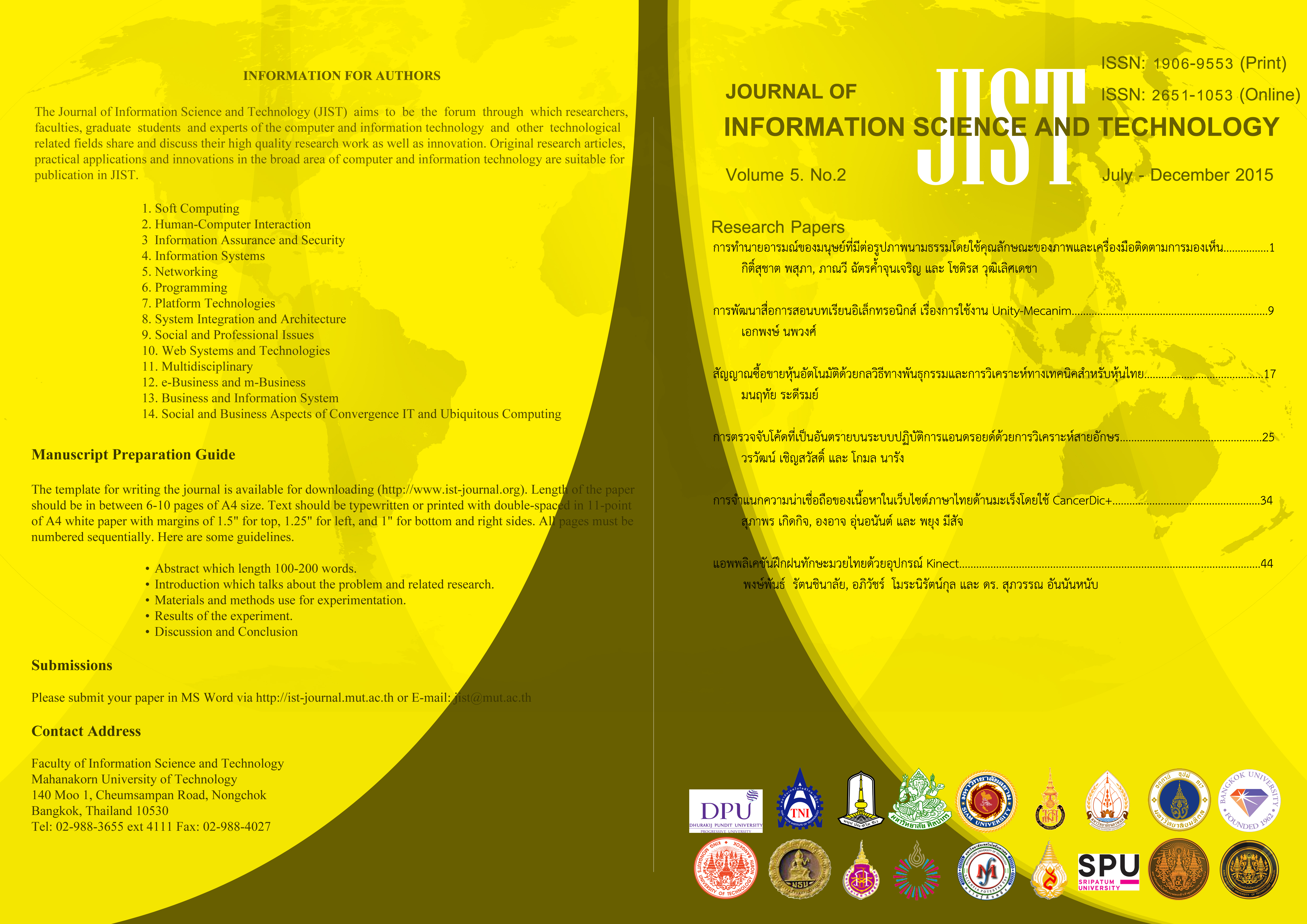Malicious Code Detection on Android Operating Systems by using Byte-Code Analysis
Main Article Content
Abstract
- This research presents a model for malware detection on mobile operating system based on machine learning technique. The objective is to reduce the risk of installing harmful application when the user did not update the anti-virus program in time. The proposed model is different to other anti-virus is that most of anti-virus software used virus signature to identify malware. However, the virus signature-based detection approach requires frequent updates of the virus signature dictionary. The signature-based approaches are not effective against new, unknown viruses while the proposed model based on machine learning can detect new malware even some parts of the code have been modified. The research processes are as follows: (1) achieving of both malicious and benign codes on android operating system, (2) Extracting features based on the distribution of n-grams frequency, and (3) constructing a model for classification the malicious codes using the extracted features for both malicious and benign codes. In the experiment, 500 malicious codes, 400 benign codes and 100 system files were used to construct the model. The experiment shows that the model achieved more than 88.9% accuracy. For the sensitivity and specificity, the model achieved 95.0% and 82.8%, respectively.
Article Details
This work is licensed under a Creative Commons Attribution-NonCommercial-NoDerivatives 4.0 International License.
I/we certify that I/we have participated sufficiently in the intellectual content, conception and design of this work or the analysis and interpretation of the data (when applicable), as well as the writing of the manuscript, to take public responsibility for it and have agreed to have my/our name listed as a contributor. I/we believe the manuscript represents valid work. Neither this manuscript nor one with substantially similar content under my/our authorship has been published or is being considered for publication elsewhere, except as described in the covering letter. I/we certify that all the data collected during the study is presented in this manuscript and no data from the study has been or will be published separately. I/we attest that, if requested by the editors, I/we will provide the data/information or will cooperate fully in obtaining and providing the data/information on which the manuscript is based, for examination by the editors or their assignees. Financial interests, direct or indirect, that exist or may be perceived to exist for individual contributors in connection with the content of this paper have been disclosed in the cover letter. Sources of outside support of the project are named in the cover letter.
I/We hereby transfer(s), assign(s), or otherwise convey(s) all copyright ownership, including any and all rights incidental thereto, exclusively to the Journal, in the event that such work is published by the Journal. The Journal shall own the work, including 1) copyright; 2) the right to grant permission to republish the article in whole or in part, with or without fee; 3) the right to produce preprints or reprints and translate into languages other than English for sale or free distribution; and 4) the right to republish the work in a collection of articles in any other mechanical or electronic format.
We give the rights to the corresponding author to make necessary changes as per the request of the journal, do the rest of the correspondence on our behalf and he/she will act as the guarantor for the manuscript on our behalf.
All persons who have made substantial contributions to the work reported in the manuscript, but who are not contributors, are named in the Acknowledgment and have given me/us their written permission to be named. If I/we do not include an Acknowledgment that means I/we have not received substantial contributions from non-contributors and no contributor has been omitted.
References
2. ธนาคารแห่งประเทศไทย, รายงานระบบการชำระเงิน 2557, https://www.bot.or.th/Thai/Pay mentSystems/ Documents/Payment_2014_T.pdf, สืบค้นเมื่อวันที่ 1 ตุลาคม 2558.
3. Jennifer Scott, Adroid set to reach one billion users in 2014, http://www.computerweek ly.com/news/2240212085 /Android-set-to-reach-one-billion-users-in-2014, สืบค้นเมื่อวันที่ 1 ตุลาคม 2558.
4. Makan, Keith, and Scott Alexander-Bown. Android Security Cookbook. Packt Publishing Ltd, 2013.
5. Dilrukshi, Inoshika, Kasun De Zoysa, and Amitha Caldera. "Twitter news classification using SVM." Computer Science & Education (ICCSE), 2013 8th International Conference on. IEEE, 2013.
6. สมภพ ปฐมนพ, กฤษฎา ศรีแผ้ว และ ม.ล.กุลธร เกษมสันต์ "ข้อมูลเชิงเวลากับการจำแนกประเภทผู้เป็นโรคเบาหวานในประเทศไทย," Journal of Information Science and Technology, Vol.4, No.1 , pp.49-56.
7. Moskovitch, Robert, Yuval Elovici, and Lior Rokach. "Detection of unknown computer worms based on behavioral classification of the host." Computational Statistics & Data Analysis 52.9 (2008): 4544-4566.
8. Abou-Assaleh, Tony, Nick Cercone, Vlado Keselj, and Ray Sweidan. "N-gram-based detection of new malicious code." In Computer Software and Applications Conference, 2004. COMPSAC 2004. Proceedings of the 28th Annual International, vol. 2, pp. 41-42. IEEE, 2004.
9. Kolter, Jeremy Z., and Marcus A. Maloof. "Learning to detect malicious executables in the wild." Journal of Machine Learning Research. Vol. 7, 2006. 2721-2744
10. Zheng, M., Sun, M., & Lui, J. Droid analytics: A signature based analytic system to collect, extract, analyze and associate android malware. In Trust, Security and Privacy in Computing and Communications (TrustCom), 2013 12th IEEE International Conference on (pp. 163-171).
11. สรวัตร ประภานิติเสถียร และ, ไกรศักดิ์ เกษร "การตรวจการโจรกรรมทางวิชาการด้วยใช้เทคนิค N-gram ร่วมกับเทคนิคการตรวจสอบเชิงความหมายสาหรับเอกสารภาษาไทย", Journal of Information Science and Technology, Vol.5, No.1 , pp.42-50.
12. Vapnik, V. The Nature of Statistical Learning Theory, Springer-Verlag, New York, 1995.
13. Lewis, David D. "Naive (Bayes) at forty: The independence assumption in information retrieval." Machine learning: ECML-98. Springer Berlin Heidelberg, 1998. 4-15.



